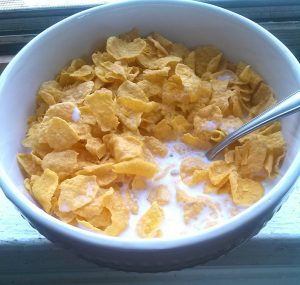- A health guru…
- Stale wheat…
- A tight budget…
This hodgepodge of events would lead to the creation of a long-time favorite cereal!
Corn Flakes’ journey began in 1877 when John Henry Kellogg (“John”) sought to provide a vegetarian diet to his patients at the Battle Creek Sanitarium in Michigan. John combined wheat, oats and cornmeal, baked them at a high temperature, then smashed the mix into little pieces. After pouring the hard morsels in a bowl and covering them with milk (to soften them), John served this nutritious breakfast to the patients.
But the concoction wasn’t corn flakes…yet.
In 1898 the cereal’s journey took an unexpected turn. A pan of the wheat mixture was accidentally left out for too long. Faced with stale wheat and budget constraints, John couldn’t bring himself to toss the tray of grains into the trash. Instead, he donned his “creative cook” hat and rolled that stale mixture into thin sheets which crumbled into flakes. He toasted them in the oven, and when they emerged, the flakes were crispy and tasted good.
But John didn’t stop there. Experimenting with corn, he discovered those flakes came out of the oven crispier and crunchier than wheat.
Voilà−Corn Flakes!

But the journey of Corn Flakes didn’t end when those crispy flakes were pulled from the oven. Notable events followed, curiosities that might whet the appetite of fiction writers. The mystery, intrigue, drama or humor surrounding Corn Flakes could be injected into a story.
Mystery: Just who was in the kitchen making something good out of those stale flakes? John Kellogg? His brother, Will? John’s wife?
Envision a character (a young reporter?) snooping around the sanitarium grounds or chatting up a group of gossipy patrons lounging in the hot tub.
Industrial Espionage: C.J. Post (Post Cereal Co.) is said to have been a patient at the sanitarium who worked in the kitchen to help pay his way. Upon his return to Texas, toasted corn flakes (“Toasties”) became part of his cereal line. Did he steal the recipe from John? Add a telling tidbit: Post beat the Kellogg brothers to the patent office to register the rolling machine.
A character could be an employee at Post Cereal during this intriguing season.
Family Drama. Add sugar to those healthy corn flakes? Anathema! Market them? Not on my watch! John’s and Will’s differing aspirations resulted in a rift between the brothers. Ultimately, Will bought the rights to Corn Flakes and by 1906 he had formed the “Battle Creek Toasted Corn Flakes Company.”

Over a bowl of Corn Flakes, a story’s characters might discuss the newspaper’s coverage of the feud or engage in a discussion about the healthiness (or not) of sugar.
“Wink at your grocer and see what you get.”
A free box of Corn Flakes!
What a playful marketing scheme by Will Kellogg!
What a playful scene to add to a story!
Imagine a 1907 male character winking at a female cashier! LOL!
Or perhaps the main character is the cashier; at first it’s fun, but being winked at all day long can get old fast.
The Rooster: In 1957 Cornelius “Corny” Rooster appeared on boxes of Kellogg’s Corn Flakes.
Picture a breakfast scene with young children enamored by the rooster.
In the 1990’s, Cornelius received a makeover. Fiction in that time period could include a debate over breakfast: which Cornelius do you like best?
And there you have it−Corn Flakes!
From the mind of a health guru to Cornelius the Rooster−who’d have guessed Corn Flakes would give us so much to crow about?

Jeannine Brummett lives in South Carolina with her husband of nineteen years, Don, who shares his three adult sons and three grandchildren with her. Reading is big on her list of things to do, but she also thrives on TV crime dramas, NBA basketball, and marvels at the critters and fowl life that live at the pond behind their house. She loves to sing praise songs, attend Bible Study, and help at a local food pantry.


 We love helping your growing in your writing career.
We love helping your growing in your writing career.

No Comments